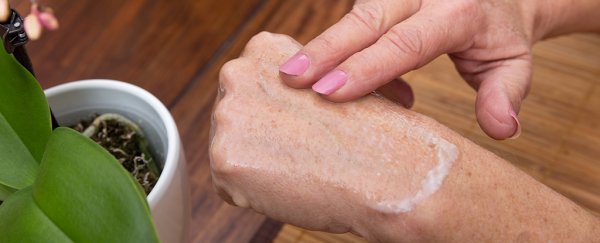A common antioxidant used as a dye in laboratories could one day be added to skin care products as way to slow the signs of ageing, a recent study on the effects of a chemical called methylene blue on human skin cells suggests.
The compound did a better job of helping cells called fibroblasts survive longer, divide faster, and show fewer indicators of ageing than several other antioxidants.
"I was encouraged and excited to see skin fibroblasts, derived from individuals more than 80 years old, grow much better in methylene blue-containing medium with reduced cellular senescence markers," said lead researcher Zheng-Mei Xiong from the University of Maryland. 'Cellular senescence' is the term used to describe when normal cells stop dividing.
Fibroblasts are part of a family of connective tissues responsible for producing materials such as cartilage or bone.
In our skin, fibroblasts produce long fibres of collagen – a key component in making your skin tough enough to resist tearing – and a protein called elastin, which adds flexability to your skin so it can stretch and pull back together.
As we age, fibroblasts produce lower amounts of collagen and higher amounts of an enzyme that breaks it apart.
Broken collagen fibres aren't as effective at giving skin a solid structure as intact fibres. They also don't give fibroblasts something to grip onto, causing them to collapse and make even less collagen, in a feedback cycle that leads to thin skin that tears easily.
Fibroblast cells also produce lower amounts of elastin over time, preventing the body's layer of skin from pulling back into a smooth, wrinkle-free surface.
Unfortunately, fibroblasts tend to divide only about 60 times before switching off, mostly because their DNA suffers increasing amounts of damage as they replicate. They also tend to stiffen with age, making it hard for the cells to move through the skin.
Lots of things can increase the damage to a fibroblast's DNA, from the ultraviolet radiation in sunlight to carcinogens in cigarette smoke. A family of chemicals called reactive oxygen species (ROS) can also rip into DNA and damage cell structures, creating what's called oxidative stress.
While we can wear sunscreen and avoid smoking, there's only so much we can do to avoid producing ROS, since they're a byproduct of our body's normal metabolism.
That's where antioxidants come in. Theoretically, these are compounds that can prevent ROS molecules from oxidising other chemicals, preventing damage.
"Our work suggests that methylene blue could be a powerful antioxidant for use in skin care products," said senior researcher Kan Cao.
"The effects we are seeing are not temporary. Methylene blue appears to make fundamental, long-term changes to skin cells."
Over four weeks, the team applied methylene blue to skin cells from healthy middle-aged donors, individuals over the age of 80, and from younger individuals with progeria – a condition which makes their body age at a faster rate.
They also applied the antioxidant to a type of artificial skin model based on living tissues arranged in layers to simulate a human epidermis.
"Most surprisingly, we saw that model skin treated with methylene blue retained more water and increased in thickness – both of which are features typical of younger skin," said Cao.
The use of this 3D living-cell epidermis model also shows promise for the future of testing cosmetics.
"Perhaps down the road we can customise the system with bioprinting, such that we might be able to use a patient's own cells to provide a tailor-made testing platform specific to their needs," said Cao.
Methylene blue isn't new to pharmacology, already commonly used to treat an overproduction of haemoglobin in a condition called methemoglobinemia.
It's also found on most microbiology laboratory benches as a stain that makes the nucleus inside plant and animal cells stand out more clearly, as well as an indicator that turns blue in the presence of oxygen.
"We have already begun formulating cosmetics that contain methylene blue. Now we are looking to translate this into marketable products," said Cao.
The concentrations used in a skin care product wouldn't be enough to turn your skin Smurf blue, but with further testing it's possible this antioxidant could help it look a little younger.
While far from a pharmaceutical fountain of youth, there are at least some studies that suggest the use of skin care products with certain antioxidants reduces the signs of ageing.
Until we have a better way to make fibroblasts behave as good as new, we might need to rely on the help antioxidants like methylene blue can provide to hold onto that baby-smooth skin.
This research was published in Scientific Reports.
